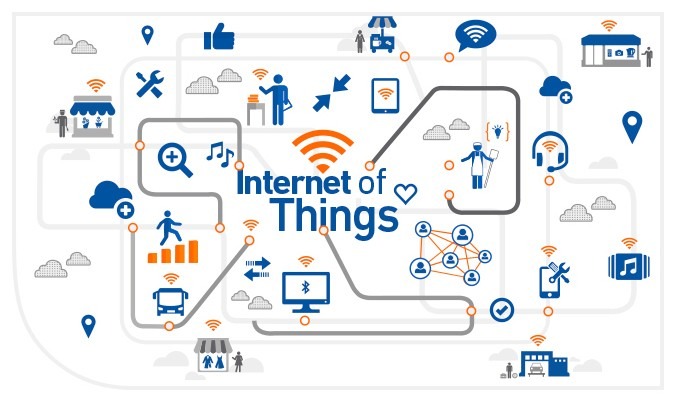1. Introduction
The convergence of blockchain and the Internet of Things (IoT) is transforming how devices connect, communicate, and share data. As billions of IoT devices come online—ranging from industrial sensors to smart home appliances—the need for secure, transparent, and tamper-proof data management has become critical. Traditional centralized systems often struggle with security vulnerabilities. Single points of failure, and limited scalability, making blockchain an ideal partner for IoT.
Blockchain’s decentralized and immutable ledger ensures that IoT-generated data is secure, verifiable, and resistant to manipulation. This combination enables automated, trustless interactions between devices, supported by smart contracts that execute predefined actions without human intervention.
Blockchain IoT app development companies are at the forefront of this transformation, creating tailored solutions for industries like supply chain, healthcare, energy, and smart cities. These solutions improve operational efficiency, enhance trust among stakeholders, and enable new business models.
In this article, we explore the rise of blockchain IoT app development companies, why this technology pairing is so powerful, the industries driving adoption, and the future trends shaping this fast-growing sector.
2. Understanding Blockchain IoT App Development
Blockchain IoT app development refers to creating applications that combine the power of blockchain technology with the connectivity of the Internet of Things (IoT). These apps leverage blockchain’s decentralized, tamper-proof ledger to enhance the security, transparency, and reliability of data generated by IoT devices.
In a typical IoT ecosystem, devices such as sensors, smart appliances, or connected vehicles constantly collect and exchange data. However, centralized data management systems can be vulnerable to hacking, unauthorized changes, or single points of failure. By integrating blockchain, IoT data is stored in an immutable ledger, ensuring it remains secure, traceable, and verifiable.
Blockchain IoT app development companies play a critical role in designing and delivering these solutions. They combine expertise in blockchain platforms—such as Ethereum, Hyperledger, Solana, and Polygon—with IoT protocols like MQTT, CoAP, and HTTP to create custom applications that meet industry-specific needs. These apps often include smart contracts to automate processes such as device authentication, payment settlements, or supply chain updates.
By merging blockchain and IoT, businesses can build applications that improve trust between stakeholders, reduce operational costs, and enable autonomous, real-time decision-making. This makes blockchain IoT app development a fast-growing field with applications across industries from logistics and healthcare to smart cities and connected vehicles.
3. Why Blockchain and IoT Are a Powerful Combination
The integration of blockchain and the Internet of Things (IoT) is revolutionizing how connected devices communicate, share, and secure data. Together, they solve many of the challenges that have limited IoT’s potential, making the combination highly attractive for businesses and developers.
Data Integrity and Tamper-Proof Records
IoT devices generate massive amounts of data, but traditional centralized systems can be vulnerable to manipulation or unauthorized access. Blockchain’s decentralized ledger ensures that once data is recorded, it cannot be altered, providing an immutable and verifiable history of events.
Secure Device-to-Device Communication
Blockchain enables direct, encrypted communication between IoT devices without relying on a central authority. This peer-to-peer model reduces the risk of hacking, data breaches, and single points of failure, making device interactions safer and more reliable.
Decentralized Network Management
In large-scale IoT deployments, managing thousands of devices can be complex. Blockchain allows for decentralized control, where devices can register, authenticate, and update themselves automatically through smart contracts, minimizing manual intervention.
Cost Savings Through Automation
Smart contracts also automate transactions and processes, such as triggering maintenance requests, initiating payments, or updating supply chain records. This reduces administrative costs, speeds up operations, and enhances overall efficiency.
Increased Transparency and Trust
Blockchain’s public or permissioned ledger ensures that all stakeholders—whether suppliers, manufacturers, or customers—can access accurate, up-to-date information, fostering trust in multi-party environments.
By combining blockchain’s trustless, transparent nature with IoT’s real-time data capabilities, businesses can create more secure, efficient, and autonomous systems. This synergy is unlocking new opportunities in smart cities, supply chains, healthcare, automotive, and energy management, positioning blockchain-IoT integration as a core driver of future digital transformation.
4. Key Services Offered by Blockchain IoT App Development Companies
Blockchain IoT app development companies provide a wide range of specialized services designed to help businesses harness the combined power of blockchain and the Internet of Things. These services address security, scalability, and automation challenges while enabling innovative, data-driven applications.
Custom IoT App Development with Blockchain Integration
These companies design and build tailored applications that connect IoT devices to blockchain networks. Solutions are customized to industry needs—whether for supply chain tracking, smart city management, or healthcare monitoring—ensuring optimal performance and security.

Smart Contract Creation for IoT Automation
Smart contracts enable autonomous execution of processes based on pre-set conditions. For IoT, this could mean automatically triggering equipment maintenance, approving a shipment, or processing micropayments without human intervention.
IoT Device Data Security Solutions
Blockchain-based encryption, decentralized identity management, and secure device authentication protect sensitive data from breaches, ensuring only authorized devices and users can access it.
Cross-Platform DApp Development
Many companies build decentralized applications (DApps) that run seamlessly across multiple platforms, allowing different IoT devices and systems to interact efficiently.
Cloud and Edge Computing Integration
To handle large-scale IoT data, developers integrate blockchain with cloud services and edge computing. This ensures faster data processing, reduced latency, and improved real-time decision-making.
Data Analytics and Visualization
Some providers also offer blockchain-backed analytics dashboards, giving stakeholders clear insights into device performance, supply chain operations, or energy consumption trends.
By offering these services, blockchain IoT app development companies enable businesses to improve trust, efficiency, and security while unlocking new revenue opportunities in industries ranging from logistics and energy to healthcare and manufacturing.
5. Industries Driving Demand for Blockchain IoT Solutions
The adoption of blockchain IoT solutions is accelerating across multiple industries, driven by the need for secure, transparent, and efficient data management. Several sectors are leading the charge:
Supply Chain and Logistics
Blockchain IoT enables real-time tracking of goods through connected sensors, with each transaction or location update recorded on an immutable ledger. This improves transparency, reduces fraud, and enhances inventory management.
Healthcare and Medical Devices
IoT-enabled medical devices generate sensitive patient data, which blockchain secures and makes tamper-proof. This ensures compliance with regulations like HIPAA while enabling trusted data sharing between healthcare providers.
Smart Cities and Infrastructure
From traffic lights to waste management systems, IoT devices in smart cities can be connected to blockchain for secure automation, efficient resource allocation, and transparent public service monitoring.
Energy and Utilities
Blockchain IoT supports smart grid management, enabling automated energy distribution, usage monitoring, and peer-to-peer energy trading. This ensures efficiency, reduces costs, and supports renewable energy initiatives.
Automotive and Connected Vehicles
Vehicles equipped with IoT sensors can use blockchain for secure communication, predictive maintenance, and automated toll or insurance payments. This improves safety, reduces downtime, and enhances user convenience.
By addressing industry-specific challenges such as data integrity, operational efficiency, and regulatory compliance, blockchain IoT solutions are becoming essential for digital transformation. As more organizations recognize their potential, demand for blockchain IoT app development companies will continue to rise, shaping the future of interconnected, secure, and intelligent systems.
6. Challenges and Considerations
While blockchain IoT solutions offer significant benefits, their adoption comes with challenges that businesses must address for successful implementation.
Scalability and Transaction Speed
Blockchain networks can face limitations in processing large volumes of IoT data in real time. Public blockchains, in particular, may struggle with transaction throughput, requiring layer-2 solutions or private blockchain setups to handle high data loads efficiently.
Interoperability
IoT ecosystems often involve diverse devices, platforms, and communication protocols. Ensuring seamless integration between different IoT systems and blockchain platforms (e.g., Ethereum, Hyperledger, Solana) can be complex and may require custom middleware solutions.
Regulatory and Compliance Issues
Industries such as healthcare, finance, and energy have strict data protection and compliance requirements. Blockchain IoT solutions must align with regulations like GDPR, HIPAA, or industry-specific standards to avoid legal risks.
Data Privacy and Cybersecurity
While blockchain secures stored data, IoT devices themselves remain vulnerable to hacking, malware, and unauthorized access. End-to-end security measures—such as device authentication, encryption, and regular security audits—are essential.
Implementation Costs
Developing and deploying blockchain IoT solutions can be expensive due to infrastructure upgrades, skilled developer costs, and ongoing maintenance. Businesses must carefully evaluate ROI before committing.
Skill Gaps
The combined expertise in blockchain and IoT is still relatively rare. Organizations may face challenges in finding or training developers proficient in both domains.
By addressing these challenges through strategic planning, technology partnerships, and strong security frameworks, businesses can maximize the benefits of blockchain IoT solutions while minimizing risks. Overcoming these considerations will be key to achieving scalable, compliant, and secure deployments.
7. Future Trends and Market Outlook
The future of blockchain IoT is set to be shaped by rapid technological advancements, increased industry adoption, and the growing need for secure, decentralized data management. Several key trends are driving this evolution:
AI-Powered IoT Blockchain Solutions
Integrating artificial intelligence with blockchain IoT will enable predictive analytics, automated decision-making, and anomaly detection. This will improve operational efficiency and enable smarter, self-managing IoT systems.
Growth of Edge Computing
Edge computing will process IoT data closer to its source, reducing latency and bandwidth usage. When combined with blockchain, this approach will enhance security and enable real-time, decentralized decision-making.
Decentralized Autonomous IoT Networks (DAOIOT)
Future IoT systems may operate as decentralized autonomous organizations, where devices self-govern using blockchain-based smart contracts, minimizing human intervention.
Integration with 5G Technology
The rollout of 5G networks will dramatically increase IoT connectivity speeds, enabling blockchain IoT applications to handle massive device networks with real-time responsiveness.
Sustainability and Green IoT
Blockchain IoT will play a role in environmental monitoring, smart energy grids, and sustainable supply chains, helping organizations meet ESG (Environmental, Social, and Governance) goals.
Market Growth Outlook
Industry analysts predict the blockchain IoT market will experience double-digit growth over the next decade, fueled by adoption in logistics, smart cities, healthcare, and energy. As demand rises, blockchain IoT app development companies will be pivotal in delivering customized, scalable, and secure solutions.
Overall, blockchain IoT is transitioning from experimental projects to mainstream deployments, positioning itself as a cornerstone technology in the next wave of digital transformation.
8. Conclusion
Blockchain IoT solutions are redefining how connected devices communicate, share, and secure data across industries. By combining blockchain’s transparency and immutability with IoT’s real-time data capabilities, businesses can achieve greater efficiency, trust, and automation. From supply chain management to smart cities and healthcare, this integration is unlocking new opportunities for innovation and operational excellence.
However, adoption comes with challenges, including scalability, interoperability, regulatory compliance, and cybersecurity. Overcoming these hurdles requires strategic planning, the right technology stack, and skilled development teams.
As trends like AI integration, edge computing, and 5G connectivity accelerate, demand for blockchain IoT app development companies will continue to grow. Businesses that embrace this technology early will not only gain a competitive edge but also help shape the future of secure, intelligent, and interconnected systems in the digital economy.



